FIAT BARCHETTA 2003 1.G Owner's Guide
Manufacturer: FIAT, Model Year: 2003, Model line: BARCHETTA, Model: FIAT BARCHETTA 2003 1.GPages: 170, PDF Size: 3.55 MB
Page 31 of 170
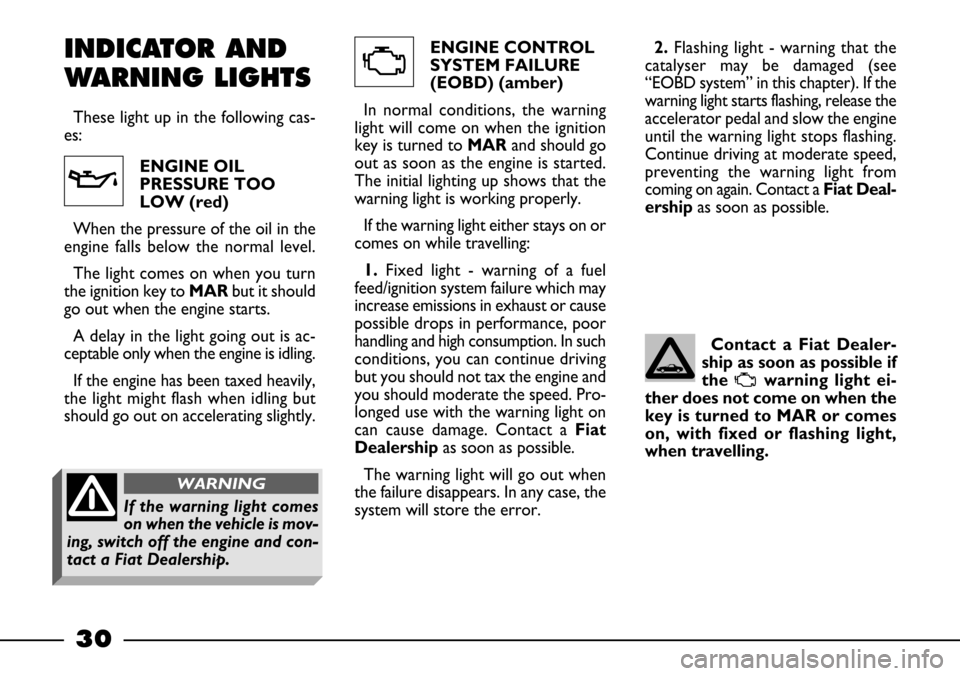
ENGINE CONTROL
SYSTEM FAILURE
(EOBD) (amber)
In normal conditions, the warning
light will come on when the ignition
key is turned to MARand should go
out as soon as the engine is started.
The initial lighting up shows that the
warning light is working properly.
If the warning light either stays on or
comes on while travelling:
1.Fixed light - warning of a fuel
feed/ignition system failure which may
increase emissions in exhaust or cause
possible drops in performance, poor
handling and high consumption. In such
conditions, you can continue driving
but you should not tax the engine and
you should moderate the speed. Pro-
longed use with the warning light on
can cause damage. Contact aFiat
Dealershipas soon as possible.
The warning light will go out when
the failure disappears. In any case, the
system will store the error. ENGINE OIL
PRESSURE TOO
LOW (red)
When the pressure of the oil in the
engine falls below the normal level.
The light comes on when you turn
the ignition key to MARbut it should
go out when the engine starts.
A delay in the light going out is ac-
ceptable only when the engine is idling.
If the engine has been taxed heavily,
the light might flash when idling but
should go out on accelerating slightly.
30
v
U
INDICATOR AND
WARNING LIGHTS
These light up in the following cas-
es:2.Flashing light - warning that the
catalyser may be damaged (see
“EOBD system” in this chapter). If the
warning light starts flashing, release the
accelerator pedal and slow the engine
until the warning light stops flashing.
Continue driving at moderate speed,
preventing the warning light from
coming on again. Contact a Fiat Deal-
ership as soon as possible.
Contact a Fiat Dealer-
ship as soon as possible if
the
Uwarning light ei-
ther does not come on when the
key is turned to MAR or comes
on, with fixed or flashing light,
when travelling.
If the warning light comes
on when the vehicle is mov-
ing, switch off the engine and con-
tact a Fiat Dealership.
WARNING
Page 32 of 170
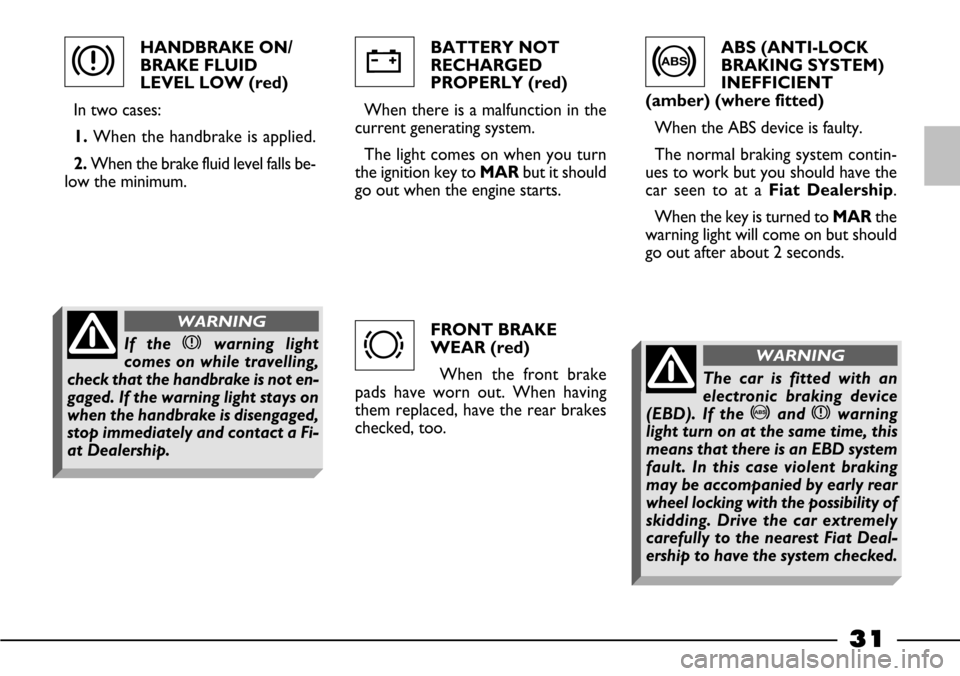
ABS (ANTI-LOCK
BRAKING SYSTEM)
INEFFICIENT
(amber) (where fitted)
When the ABS device is faulty.
The normal braking system contin-
ues to work but you should have the
car seen to at a Fiat Dealership.
When the key is turned toMARthe
warning light will come on but should
go out after about 2 seconds. HANDBRAKE ON/
BRAKE FLUID
LEVEL LOW (red)
In two cases:
1. When the handbrake is applied.
2. When the brake fluid level falls be-
low the minimum.BATTERY NOT
RECHARGED
PROPERLY (red)
When there is a malfunction in the
current generating system.
The light comes on when you turn
the ignition key to MARbut it should
go out when the engine starts.
FRONT BRAKE
WEAR (red)
When the front brake
pads have worn out. When having
them replaced, have the rear brakes
checked, too.
31
w>
d
x
If the xwarning light
comes on while travelling,
check that the handbrake is not en-
gaged. If the warning light stays on
when the handbrake is disengaged,
stop immediately and contact a Fi-
at Dealership.
WARNING
The car is fitted with an
electronic braking device
(EBD). If the >and xwarning
light turn on at the same time, this
means that there is an EBD system
fault. In this case violent braking
may be accompanied by early rear
wheel locking with the possibility of
skidding. Drive the car extremely
carefully to the nearest Fiat Deal-
ership to have the system checked.
WARNING
Page 33 of 170
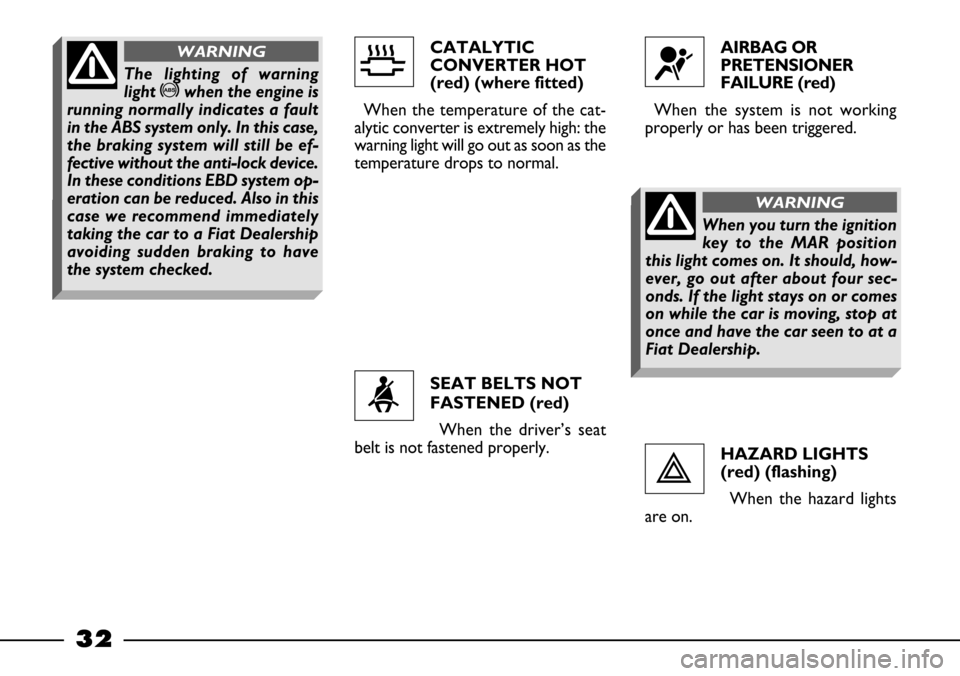
HAZARD LIGHTS
(red) (flashing)
When the hazard lights
are on.AIRBAG OR
PRETENSIONER
FAILURE (red)
When the system is not working
properly or has been triggered.
SEAT BELTS NOT
FASTENED (red)
When the driver’s seat
belt is not fastened properly. CATALYTIC
CONVERTER HOT
(red) (where fitted)
When the temperature of the cat-
alytic converter is extremely high: the
warning light will go out as soon as the
temperature drops to normal.
32
<
f¬
r
When you turn the ignition
key to the MAR position
this light comes on. It should, how-
ever, go out after about four sec-
onds. If the light stays on or comes
on while the car is moving, stop at
once and have the car seen to at a
Fiat Dealership.
WARNING
The lighting of warning
light >when the engine is
running normally indicates a fault
in the ABS system only. In this case,
the braking system will still be ef-
fective without the anti-lock device.
In these conditions EBD system op-
eration can be reduced. Also in this
case we recommend immediately
taking the car to a Fiat Dealership
avoiding sudden braking to have
the system checked.
WARNING
Page 34 of 170
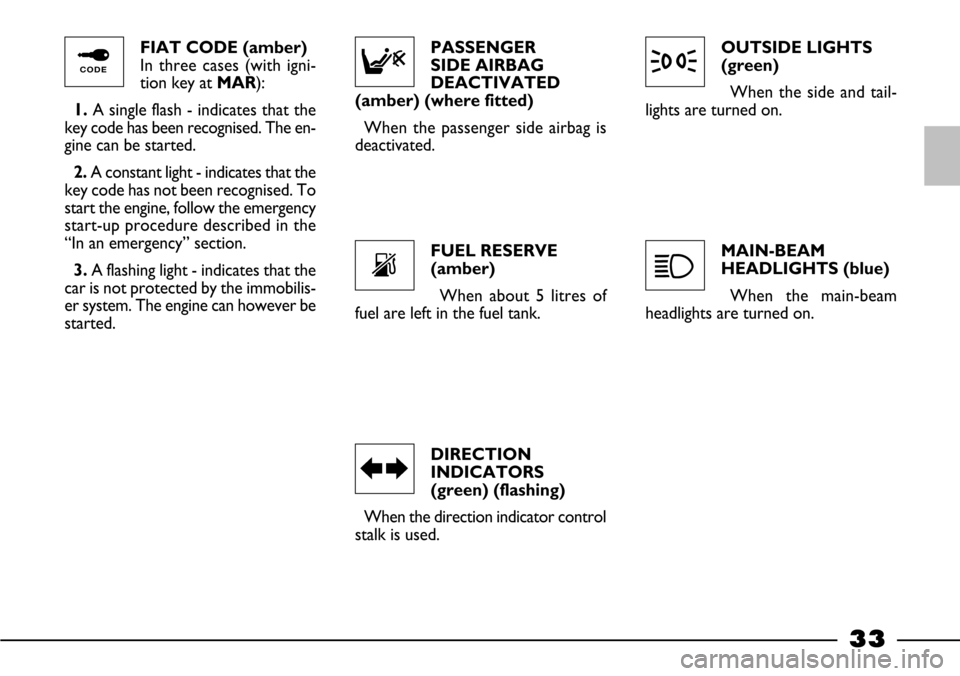
MAIN-BEAM
HEADLIGHTS (blue)
When the main-beam
headlights are turned on.OUTSIDE LIGHTS
(green)
When the side and tail-
lights are turned on.
DIRECTION
INDICATORS
(green) (flashing)
When the direction indicator control
stalk is used.FUEL RESERVE
(amber)
When about 5 litres of
fuel are left in the fuel tank.PASSENGER
SIDE AIRBAG
DEACTIVATED
(amber) (where fitted)
When the passenger side airbag is
deactivated. FIAT CODE (amber)
In three cases (with igni-
tion key at MAR):
1. A single flash - indicates that the
key code has been recognised. The en-
gine can be started.
2. A constant light - indicates that the
key code has not been recognised. To
start the engine, follow the emergency
start-up procedure described in the
“In an emergency” section.
3. A flashing light - indicates that the
car is not protected by the immobilis-
er system. The engine can however be
started.
33
°
RE
3
1
¢F
Page 35 of 170
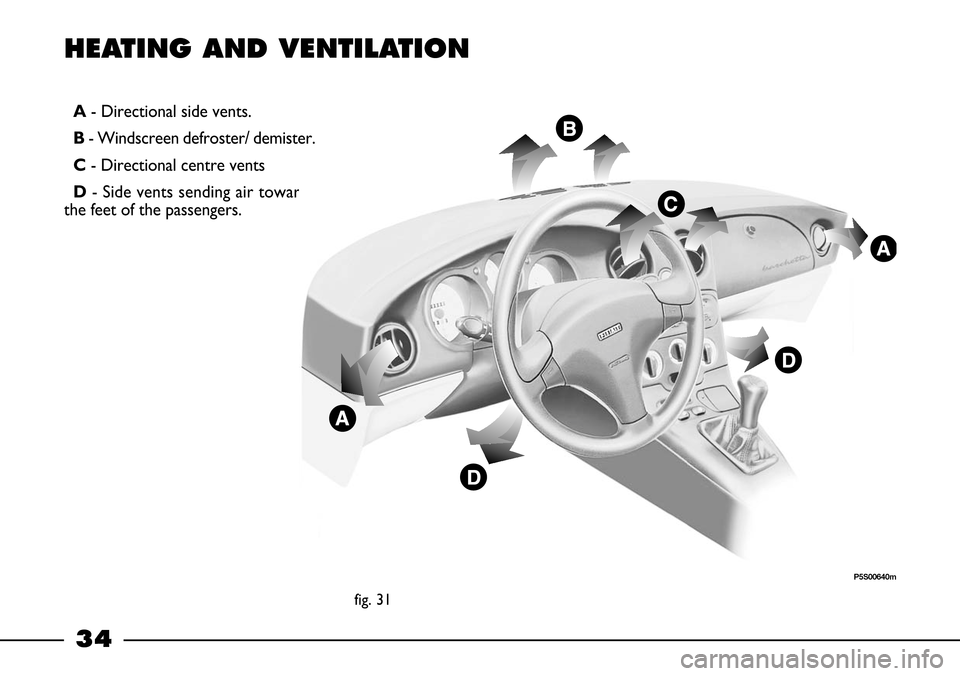
34
A- Directional side vents.
B- Windscreen defroster/ demister.
C- Directional centre vents
D- Side vents sending air towards
the feet of the passengers.
HEATING AND VENTILATION
fig. 31
P5S00640m
Page 36 of 170
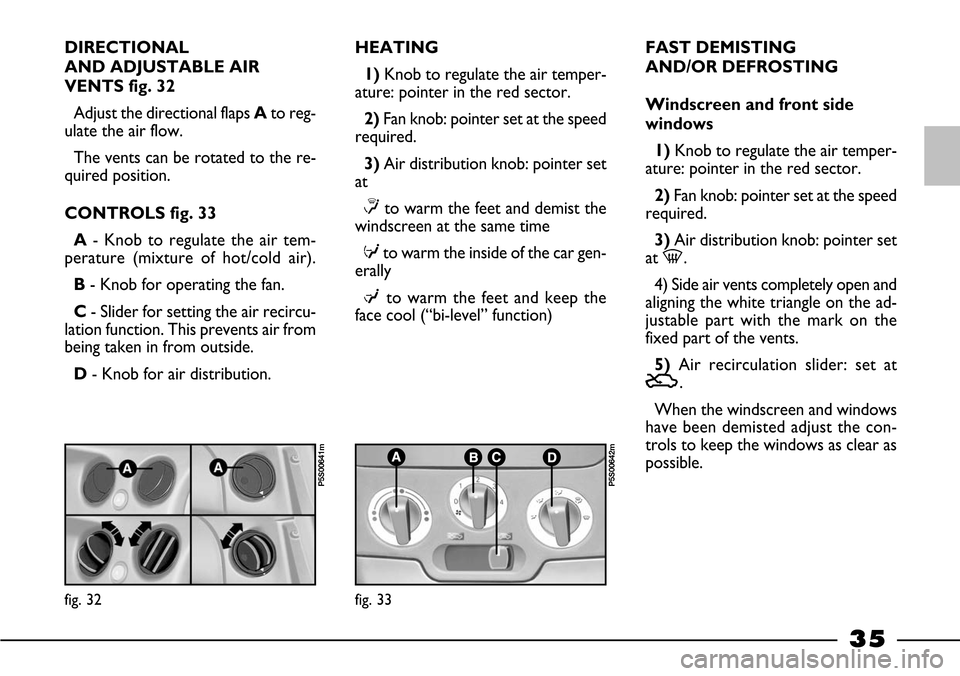
35
fig. 33
P5S00642m
fig. 32
P5S00641m
DIRECTIONAL
AND ADJUSTABLE AIR
VENTS fig. 32
Adjust the directional flaps Ato reg-
ulate the air flow.
The vents can be rotated to the re-
quired position.
CONTROLS fig. 33
A - Knob to regulate the air tem-
perature (mixture of hot/cold air).
B- Knob for operating the fan.
C- Slider for setting the air recircu-
lation function. This prevents air from
being taken in from outside.
D- Knob for air distribution.HEATING
1)Knob to regulate the air temper-
ature: pointer in the red sector.
2) Fan knob: pointer set at the speed
required.
3)Air distribution knob: pointer set
at
≤to warm the feet and demist the
windscreen at the same time
≥to warm the inside of the car gen-
erally
µto warm the feet and keep the
face cool (“bi-level” function)FAST DEMISTING
AND/OR DEFROSTING
Windscreen and front side
windows
1)Knob to regulate the air temper-
ature: pointer in the red sector.
2) Fan knob: pointer set at the speed
required.
3) Air distribution knob: pointer set
at -.
4) Side air vents completely open and
aligning the white triangle on the ad-
justable part with the mark on the
fixed part of the vents.
5) Air recirculation slider: set at
U.
When the windscreen and windows
have been demisted adjust the con-
trols to keep the windows as clear as
possible.
Page 37 of 170
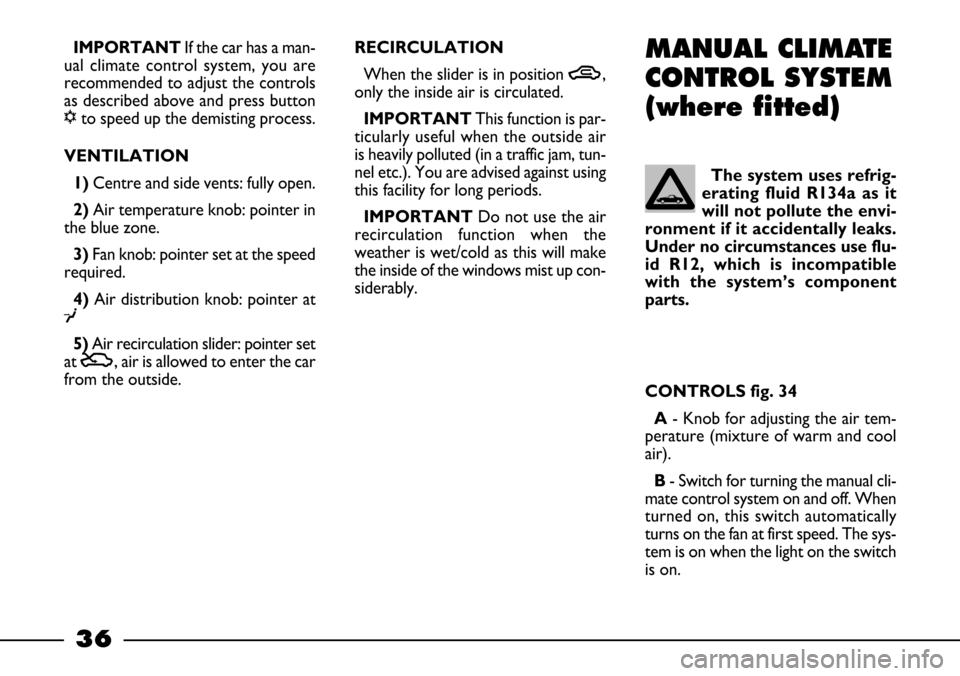
36
IMPORTANTIf the car has a man-
ual climate control system, you are
recommended to adjust the controls
as described above and press button
√to speed up the demisting process.
VENTILATION
1)Centre and side vents: fully open.
2) Air temperature knob: pointer in
the blue zone.
3) Fan knob: pointer set at the speed
required.
4) Air distribution knob: pointer at
¥
5)Air recirculation slider: pointer set
at U, air is allowed to enter the car
from the outside.RECIRCULATION
When the slider is in position T,
only the inside air is circulated.
IMPORTANTThis function is par-
ticularly useful when the outside air
is heavily polluted (in a traffic jam, tun-
nel etc.). You are advised against using
this facility for long periods.
IMPORTANTDo not use the air
recirculation function when the
weather is wet/cold as this will make
the inside of the windows mist up con-
siderably.MANUAL CLIMATE
CONTROL SYSTEM
(where fitted)
The system uses refrig-
erating fluid R134a as it
will not pollute the envi-
ronment if it accidentally leaks.
Under no circumstances use flu-
id R12, which is incompatible
with the system’s component
parts.
CONTROLS fig. 34
A- Knob for adjusting the air tem-
perature (mixture of warm and cool
air).
B- Switch for turning the manual cli-
mate control system on and off. When
turned on, this switch automatically
turns on the fan at first speed. The sys-
tem is on when the light on the switch
is on.
Page 38 of 170
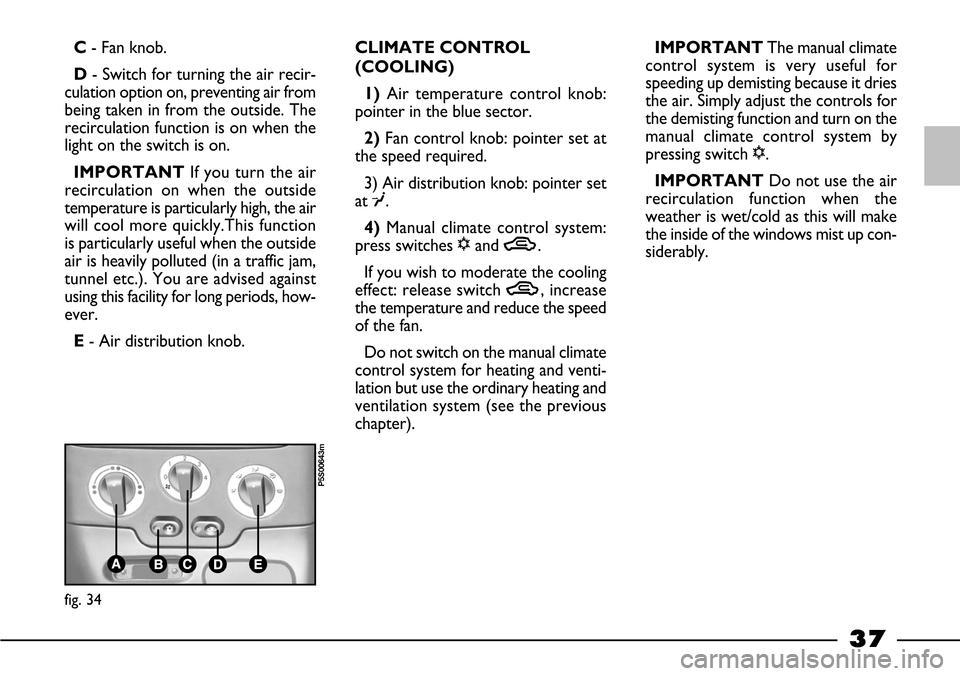
37
C- Fan knob.
D- Switch for turning the air recir-
culation option on, preventing air from
being taken in from the outside. The
recirculation function is on when the
light on the switch is on.
IMPORTANTIf you turn the air
recirculation on when the outside
temperature is particularly high, the air
will cool more quickly.This function
is particularly useful when the outside
air is heavily polluted (in a traffic jam,
tunnel etc.). You are advised against
using this facility for long periods, how-
ever.
E- Air distribution knob.CLIMATE CONTROL
(COOLING)
1) Air temperature control knob:
pointer in the blue sector.
2)Fan control knob: pointer set at
the speed required.
3) Air distribution knob: pointer set
at ¥.
4)Manual climate control system:
press switches √and T.
If you wish to moderate the cooling
effect: release switch T, increase
the temperature and reduce the speed
of the fan.
Do not switch on the manual climate
control system for heating and venti-
lation but use the ordinary heating and
ventilation system (see the previous
chapter).IMPORTANTThe manual climate
control system is very useful for
speeding up demisting because it dries
the air. Simply adjust the controls for
the demisting function and turn on the
manual climate control system by
pressing switch √.
IMPORTANTDo not use the air
recirculation function when the
weather is wet/cold as this will make
the inside of the windows mist up con-
siderably.
fig. 34
P5S00643m
Page 39 of 170
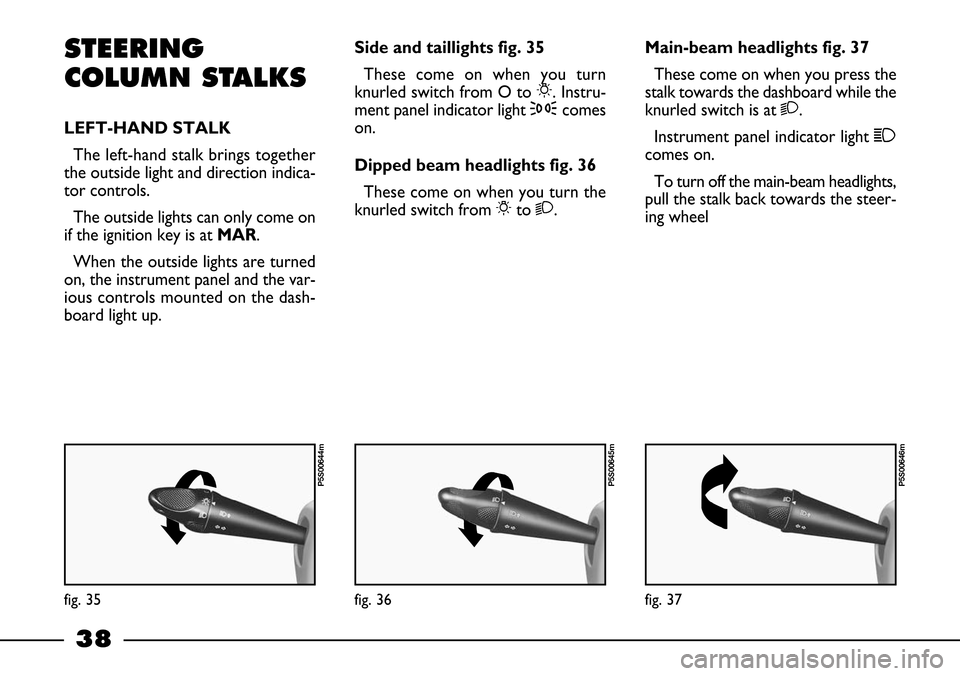
38
STEERING
COLUMN STALKS
LEFT-HAND STALK
The left-hand stalk brings together
the outside light and direction indica-
tor controls.
The outside lights can only come on
if the ignition key is at MAR.
When the outside lights are turned
on, the instrument panel and the var-
ious controls mounted on the dash-
board light up.Side and taillights fig. 35
These come on when you turn
knurled switch from O to 6. Instru-
ment panel indicator light 3comes
on.
Dipped beam headlights fig. 36
These come on when you turn the
knurled switch from 6to 2.Main-beam headlights fig. 37
These come on when you press the
stalk towards the dashboard while the
knurled switch is at 2.
Instrument panel indicator light 1
comes on.
To turn off the main-beam headlights,
pull the stalk back towards the steer-
ing wheel
fig. 35
P5S00644m
fig. 36
P5S00645m
fig. 37
P5S00646m
Page 40 of 170
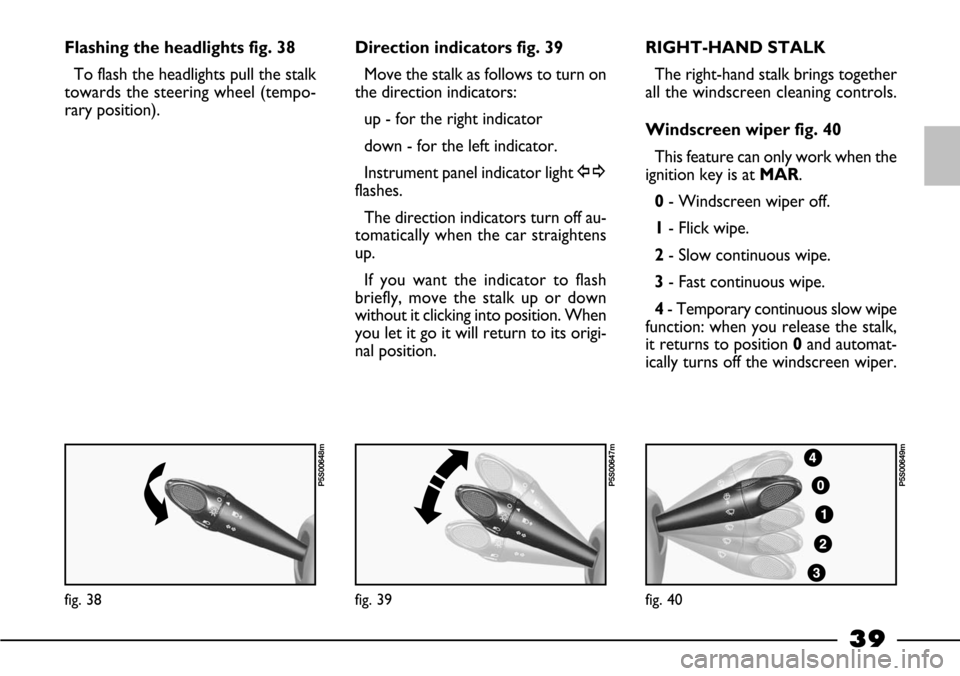
39
Flashing the headlights fig. 38
To flash the headlights pull the stalk
towards the steering wheel (tempo-
rary position).Direction indicators fig. 39
Move the stalk as follows to turn on
the direction indicators:
up - for the right indicator
down - for the left indicator.
Instrument panel indicator light y
flashes.
The direction indicators turn off au-
tomatically when the car straightens
up.
If you want the indicator to flash
briefly, move the stalk up or down
without it clicking into position. When
you let it go it will return to its origi-
nal position.RIGHT-HAND STALK
The right-hand stalk brings together
all the windscreen cleaning controls.
Windscreen wiper fig. 40
This feature can only work when the
ignition key is at MAR.
0- Windscreen wiper off.
1- Flick wipe.
2- Slow continuous wipe.
3- Fast continuous wipe.
4 - Temporary continuous slow wipe
function: when you release the stalk,
it returns to position 0and automat-
ically turns off the windscreen wiper.
fig. 38
P5S00648m
fig. 40
P5S00649m
fig. 39
P5S00647m